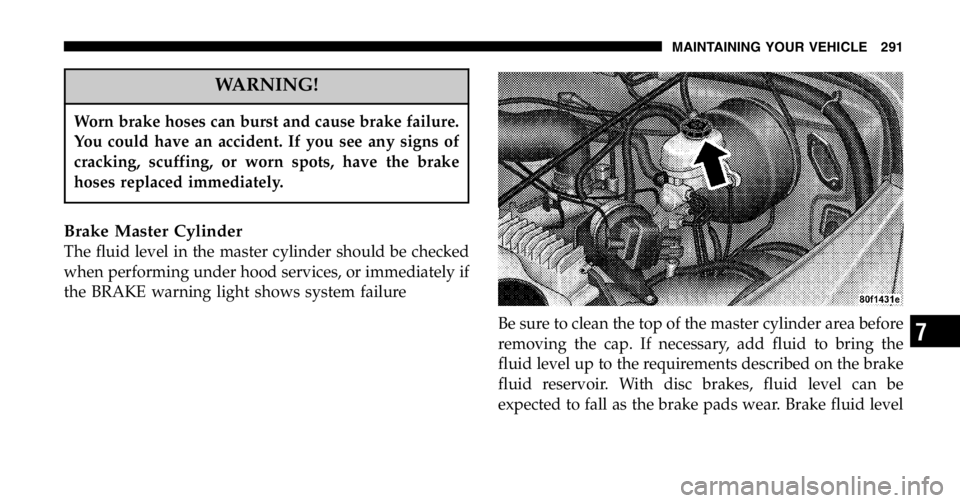ECU JEEP WRANGLER 2006 Owners Manual
[x] Cancel search | Manufacturer: JEEP, Model Year: 2006, Model line: WRANGLER, Model: JEEP WRANGLER 2006Pages: 1472, PDF Size: 12.64 MB
Page 19 of 1472

WARNING!
Carefully follow these warnings to help protect against
personal injury:
•Do not drive your vehicle on-road with the windshield
down.
•Do not drive your vehicle unless the windshield is
securely fastened, either up or down.
•Eye protection, such as goggles, should be worn at all
times when the windshield is down.
•Be sure that you carefully follow the instructions for
raising the windshield. Make sure that the folding
windshield, windshield wipers, side bars, and all
associated hardware and fasteners are correctly and
tightly assembled before driving your vehicle. Failure
to follow these instructions may prevent your vehicle
from providing you and your passengers protection in
some accidents.
•If you remove the doors, store them outside the ve-
hicle. In the event of an accident, a loose door may
cause personal injury.
Page 145 of 1472

are present. Components should be replaced immedi-
ately if there is any evidence of degradation that could
cause failure.
Brake System
In order to assure brake system performance, all brake
system components should be inspected periodically.
Refer to the appropriate “Maintenance Schedule” in
Section 8 for suggested service intervals.
WARNING!
Riding the brakes can lead to brake failure and
possibly an accident. Driving with your foot resting
or riding on the brake pedal can result in abnormally
high brake temperatures, excessive lining wear, and
possible brake damage. You wouldn’t have your full
braking capacity in an emergency.
Brake and Power Steering System Hoses
When servicing the vehicle for scheduled maintenance,
inspect surface of hoses for evidence of heat and me-
chanical damage. Hard and brittle rubber, cracking, tears,
cuts, abrasion, and excessive swelling suggest deteriora-
tion of the rubber. Particular attention should be made to
examining those hose surfaces nearest to high heat
sources, such as the exhaust manifold.
Inspect all hose clamps and couplings to make sure they
are secure and no leaks are present.
NOTE: Inspection of brake hoses should be done when-
ever the brake system is serviced and every engine oil
change.
290 MAINTAINING YOUR VEHICLE
Page 198 of 1472

An incorrectly anchored tether strap could lead to
increased head motion and possible injury to the
child. Use only the anchor positions directly behind
the child seat to secure a child restraint top tether
strap.
Children Too Large for Booster Seats
Children who are large enough to wear the shoulder belt
comfortably, and whose legs are long enough to bend
over the front of the seat when their back is against the
seat back should use the lap/shoulder belt in a rear seat.
•Make sure that the child is seated upright in the seat.
•The lap belt portion should be low on the hips and as
snug as possible.
2
Page 289 of 1472

WARNING!
Carefully follow these warnings to help protect against
personal injury:
•Do not drive your vehicle on-road with the windshield
down.
•Do not drive your vehicle unless the windshield is
securely fastened, either up or down.
•Eye protection, such as goggles, should be worn at all
times when the windshield is down.
•Be sure that you carefully follow the instructions for
raising the windshield. Make sure that the folding
windshield, windshield wipers, side bars, and all
associated hardware and fasteners are correctly and
tightly assembled before driving your vehicle. Failure
to follow these instructions may prevent your vehicle
from providing you and your passengers protection in
some accidents.
•If you remove the doors, store them outside the ve-
hicle. In the event of an accident, a loose door may
cause personal injury.
Page 291 of 1472

CAUTION!
Do not remove the head impact foam from the side
bars, as damage to the foam may result.
You or others could be injured if you carry the side
bars loose in your vehicle. Remove the bars from the
vehicle or securely store them as described or they
may cause personal injury if an accident occurs. See
your authorized dealer for replacement if the cinch
straps are not found in the glove box.
Page 293 of 1472

9. Secure the windshield by passing the remaining cinch
strap, found in the glove box, through the footman hoop
on the center of the hood and on the center of the
windshield frame. Tighten the strap to secure the wind-
shield in place.Raising The Windshield And Replacing Side Bars
To raise the windshield, install the windshield wipers,
and install the side bars use these same steps in reverse.
WARNING!
To help protect against personal injury, always in-
stall the side bars when raising the windshield on
your vehicle. If you do not raise the windshield and
install the side bars, you lose the protection these
structural elements provide in some accidents.
Page 345 of 1472

WARNING!
Unintended movement of a vehicle could injure
those in and near the vehicle. As with all vehicles,
you should never exit a vehicle while the engine is
running. Before exiting a vehicle, you should always
shift the vehicle into P (Park), remove the key from
the ignition, and apply the parking brake. Once the
key is removed from the ignition, the transmission
shift lever is locked in the P (Park) position, securing
the vehicle against unwanted movement. Further-
more, you should never leave children unattended
inside a vehicle.
Before moving the shift lever out of P (Park), you
must turn the ignition from LOCK to ON so the
steering wheel and shift lever are released. Other-
wise, damage to the steering column or shifter could
result.
Page 397 of 1472

Towing Requirements
To promote proper break-in of your new vehicle drivetrain
components the following guidelines are recommended:
NOTE: Trailer towing requires special rear axle lubri-
cant. Refer to “Fluids, Lubricants, and Genuine Parts” in
Section 7 for more information.
CAUTION!
Improper towing can lead to an injury accident.
Follow these guidelines to make your trailer towing
as safe as possible:
Make certain that the load is secured in the trailer
and will not shift during travel. When trailering
cargo that is not fully secured, dynamic load shifts
can occur that may be difficult for the driver to
control. You could lose control of your vehicle and
have an accident.
Page 445 of 1472

are present. Components should be replaced immedi-
ately if there is any evidence of degradation that could
cause failure.
Brake System
In order to assure brake system performance, all brake
system components should be inspected periodically.
Refer to the appropriate “Maintenance Schedule” in
Section 8 for suggested service intervals.
WARNING!
Riding the brakes can lead to brake failure and
possibly an accident. Driving with your foot resting
or riding on the brake pedal can result in abnormally
high brake temperatures, excessive lining wear, and
possible brake damage. You wouldn’t have your full
braking capacity in an emergency.
Brake and Power Steering System Hoses
When servicing the vehicle for scheduled maintenance,
inspect surface of hoses for evidence of heat and me-
chanical damage. Hard and brittle rubber, cracking, tears,
cuts, abrasion, and excessive swelling suggest deteriora-
tion of the rubber. Particular attention should be made to
examining those hose surfaces nearest to high heat
sources, such as the exhaust manifold.
Inspect all hose clamps and couplings to make sure they
are secure and no leaks are present.
NOTE: Inspection of brake hoses should be done when-
ever the brake system is serviced and every engine oil
change.
290 MAINTAINING YOUR VEHICLE
Page 533 of 1472

are present. Components should be replaced immedi-
ately if there is any evidence of degradation that could
cause failure.
Brake System
In order to assure brake system performance, all brake
system components should be inspected periodically.
Refer to the appropriate “Maintenance Schedule” in
Section 8 for suggested service intervals.
WARNING!
Riding the brakes can lead to brake failure and
possibly an accident. Driving with your foot resting
or riding on the brake pedal can result in abnormally
high brake temperatures, excessive lining wear, and
possible brake damage. You wouldn’t have your full
braking capacity in an emergency.
Brake and Power Steering System Hoses
When servicing the vehicle for scheduled maintenance,
inspect surface of hoses for evidence of heat and me-
chanical damage. Hard and brittle rubber, cracking, tears,
cuts, abrasion, and excessive swelling suggest deteriora-
tion of the rubber. Particular attention should be made to
examining those hose surfaces nearest to high heat
sources, such as the exhaust manifold.
Inspect all hose clamps and couplings to make sure they
are secure and no leaks are present.
NOTE: Inspection of brake hoses should be done when-
ever the brake system is serviced and every engine oil
change.
290 MAINTAINING YOUR VEHICLE